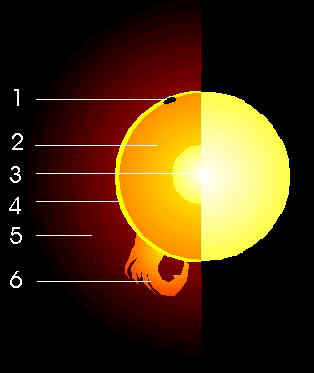Star Structure
Wall of Distinction (UNDER CONSTRUCTION) |
BuPers |
Library |
Home |
SF Engineering |
SF Intelligence |
SF JAG |
SF Marine Corps |
SF Medical |
SF Public Affairs |
SF Records |
SF Sciences |
SF SECIS
Federation News Network (FNN) |
UFP Dept. of Colonial Affairs |
UFP Educational, Scientific and Cultural Org.
General
The majority of stars discovered are at the stage described below, with variations in temperature, size and composition depending on age. A star is mainly made of Hydrogen (70%), Helium (28%) and other heavier materials (2%). Such a star can be divided in to several sections:
Photosphere (4)
The Photopshere is a visible atmosphere of hot gases. It's mottled appearance comes from the turbulance below in the Convection Zone and is known as solar granulation. Most stars also have what is known as supergranulation, which is solar granulation on a much larger and longer scale. The temperature of the Photosphere is about 6000 K.
Corona (5)
The Corona, the stars 'outer atmoshpere', extends far out in to space. These arches of hot gases and smaller arches follow magnetic lines of force. At the base of the corona, above the Photosphere, is what is known as the Chromosphere. It is at approximately 30,000 K, while the corona, extending much further than the Chromosphere is at about 1,000,000 K. Another phenomenon of the Corona is what is known as prominences. This is cool material trapped in the Photosphere by the strong magnetic forces of the Corona. Occasionally these erupt and spray solar material in to space, but most fade away in a few days.
Stellar Wind
Stellar wind comes from what is known as coronal holes. These are areas where the magenetic forces of the Cornona are not as strong, and the hot gases of the Corona escape and fly out in to space at very high speeds along the stars magnetic lines of force. Solar wind can easily stretch out and beyond planets around the star. This region the solar wind effects is known as the heliospehere, which normally stretches well beyond most planets that orbit the star. Beyond the heliosphere is the heliosheath; the area of space where the solar flare and the suns magnetic field interacts with interstellar dust and gas outside of the star system. The well-defiend boundry between the heliosphere and heliosheath is called the heliopause. The heliosphere is sometimes also known as the Interplanetary magnetic field (IMF).
Convection Zone (2)
The area below the visible Photosphere but which does not initiate nuclear fusion is called the Convection Zone. The temperatur and pressure increases steadily as you go deeper in to the star. The Convection Zone has large currents and a lot of turbulance.
The Core (3)
The core, extending out to about 25% of the stars total radius, is where nuclear fusion happens. Temperatures in the core are around 16,000,000 K, at 150 times the density of water (typical Star). Under these conditions, the nuclei of hydrogen atoms combine together to form helium. The energy released is in the form of gamma radiation, and equals approximately 100 billion one megaton hydrogen bombs per-second.
Sunspot (1)
The appearance of black "sunspots" are simply cooler parts of the Photosphere. Sunspots are still incredibly hot, but appear dark in comparison to the far hotter normal Photosphere.
Solar Flare/Prominance (6)
A Solar Flare is a massive eruption of hot gaseous material on the suns surface, accompanied by large radiation bursts and electromagnetic radiation bursts. See Corona for more on Prominences.
Additional Information
For additional information see: Star Classes
Disclaimer
This material was developed for use in ASR and is not intended to apply anywhere outside ASR. You are welcome to bookmark our pages and view them repeatedly without being a player in ASR. No other use of the material contained within the ASR Manual- including copying or altering any of the pages within for one's own use- is permitted. For further information about joining ASR, please click here.
